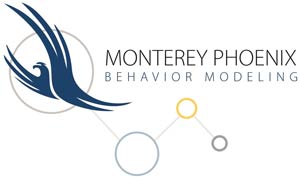Uses - Monterey Phoenix
We build models to ask and answer questions...
...questions about system, system of systems (SoS), and process behaviors.
Students, researchers and practitioners are using MP to answer questions such as:
- What is the intended sequence of events?
- How should the system handle disruptions?
- How many scenarios contain unexpected behaviors?
- What formal constraints / requirements will prevent unwanted unexpected behaviors?
- Which events must be managed as an enterprise risk?
- Which are the critical decision points?
- Which have the highest consequence?
- What is the expected duration of a behavior sequence (scenario)?
- What is the downstream consequence of an upstream disruption?
- What behavior patterns are present in the model?
- Is a presented pattern also applicable in other domains?
- In which traces are certain wanted or unwanted behaviors or patterns present?
Other questions that can be answered with MP :
- Is a known unwanted behavior absent from all traces / the design?
- What could the unwanted behaviors have cost later, had they not been exposed early?
- How many valid event traces remain after removal of unwanted event traces?
- How many failure modes are included among the valid event traces?
- What is the probability or likelihood of an event or outcome?
- Given the presence or absence of other events?
- What is the likelihood of success/failure?
- Which behaviors have the most severe impact / consequence and how likely are they to occur?
- How should event traces be prioritized for the risk management?
-
What is the expected/minimum/maximum value of a resource (time, money, fuel, power, water, food, projectiles, waste, etc.) a process / behavior sequence can produce or consume at a given scope?
- What is the probability or likelihood a process will produce or consume more or less of a resource in a given amount of time?
-
How is overall behavior impacted if not enough resources are available for a given event to start or finish?

Application Domains
Mission Engineering
This solution-neutral operational process model of a Search and Rescue (SAR) mission shows the required interactions among five participants.

Business Process / Workflow Modeling
Business Process / Workflow Modeling This model of the spiral software process illustrates the use of MP to model high level processes employed by individual roles within an organization.

Policy
A model of an overdose situation to inform policy on rescue medication administration turns up an unintended scenario in which the victim receives the rescue medication twice from lack of coordination.

Autonomous Systems
A UAV is decomposed into subfunctions that interact with the operator and the environment. Automated annotations describe important aspects of this scenario.

Aero
A commercial flight is modeled, showing interactions among passenger, pilot and controller (top row) across seven phases (left column).

Space
A scenario from a model of a spacecraft communications system as it approaches to dock with the International Space Station (ISS). The absence of this particular scenario from the model was noticed and subsequently corrected by the student author.

Software Architecture
A scenario from an MP model of an unconstrained stack (allowed to try to pop an empty stack) illustrates how to pinpoint events that violate a certain property, and how to annotate these particular events in the trace with additional messages.

Networks & Communications
An example scenario from a model of network ring, where each node interacts with its left and right neighbors only.

General Systems and Emergence Research
An MP model of the Cycles isomorphic systems process (ISP) containing two of at least five cycles patterns shown to arise from a small model of 6 lines of code.

Automotive
A scenario from a model of an autonomous automobile's interactions with its user.

Manufacturing
A scenario from a model of a manufacturing process.

Logistics
A scenario from a model of a logistics process (two producers, transportation, supply office, and two consumers).

Lifecycle Phase Application Examples
Concept of Operations
Use MP during concept development to create a model of the problem. Show the MP event traces to stakeholders for feedback on whether or not the model accurately and fully captures the problem to be solved. Fix misinterpretations about the problem.
Requirements & Architecture
Use MP to describe the architecture-level behavior that solves the problem of interest. Formulate and test the logic, completeness and consistency of requirements for the system under design. Fix misinterpretations and errors pertaining to the architecture of behavior of the high level elements.
Requirements & Architecture
Use MP to describe the architecture-level behavior that solves the problem of interest. Formulate and test the logic, completeness and consistency of requirements for the system under design. Fix misinterpretations and errors pertaining to the architecture of behavior of the high level elements.
System Verification & Validation
MP helps us make more complete predictions about possible alternative system behaviors, learn about critical issues are concerning interactions among parts of the system and between the system and its environment, and exclude undesired behaviors from the design before their manifestation in the actual system. With MP, verification & validation of the system model is concurrent with model development throughout every phase of the lifecycle. During this phase the actual system behavior is checked against the MP-modeled system behavior.
Detailed Design
Use MP to describe the detailed behaviors as allocated to software, hardware, people, facilities, or some combination thereof. Fix errors in component behaviors.
Operations & Maintenance
An MP model of a fielded system may be used as a "digital twin" to verify and validate proposed changes to the configuration before actually making those changes in the real system.

